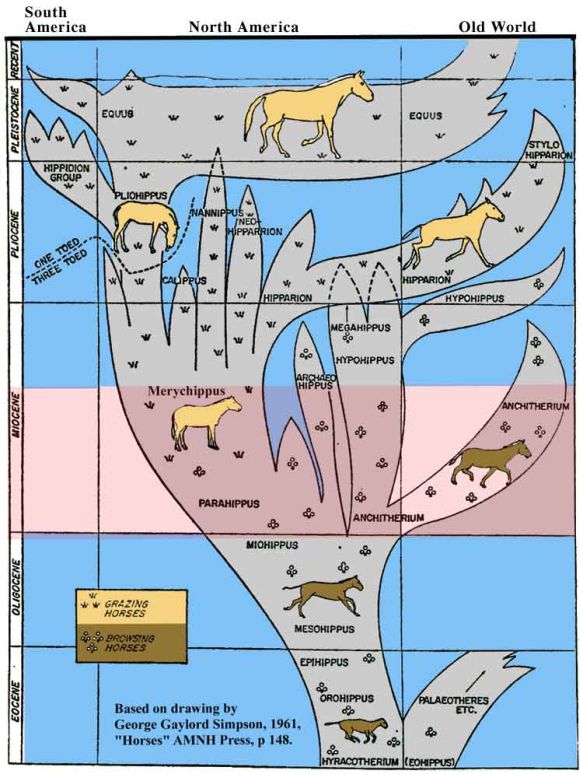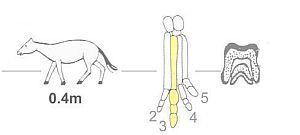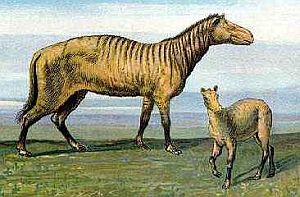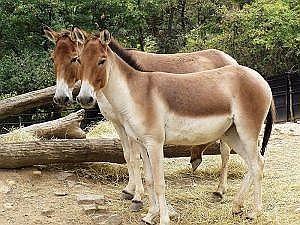
The embodiment of man was not prepared
by the uprising of the human body.
The body rose up,
as the form became human.
Louis Bolk
Evolution of the horse
No evolution of any species is as well documented as that of the horse. A great number of fossils have been found, that show the changes over tens of millions of years. The fossils are classified in dozens of genera and hundreds of species, as is shown in the figure below. The evolution of the horse took place mainly in North America. From there, the animals dispersed to Asia, Africa and Europe several times and twice to South America. The development of the horse is a process of trial and error. Many species arise and become extinct again and many branches run dead; only one line continues. Mindful of "survival of the fittest" horses, adapted to their environment again and again, adjusting to their surroundings. This brought changes, horses became more and more horse, more and more specialized. Eventually horses died out in America 8,000 years ago and they were reintroduced by the Spaniards in the 15th century. Indians did not have horses until then. Luckily horses still live on in the Old World.

The evolution of the horse
The evolution of horses mainly occurred in America in the Tertiary, the time to the Pleistocene. 55 million years ago, in the Eocene, the first horses emerged, and in the Miocene many genera and species existed, which disappeared in the Pliocene. Only the genus Equus remained. That genus was widely spread in the Pleistocene, until the horse became extinct in America 8000 years ago. So, the heyday of the horse is already far behind us.
First, some species will be described, followed by a closer look at some physical characteristics and some conclusions.
Species
Eohippus
The first animal that is classified as equine is called Eohippus (or Hyracotherium). This animal lived approximately 55-50 million years ago and was as big as a fox with a shoulder height of 25 - 45 cm. It had posterior emphasis; the hind legs longer than the forelegs and a long tail. The head was relatively short and the back was curved. It was an agile animal that lived in the forest.
The teeth are those of an omnivore: 3 incisors, 1 canine, 3 premolars and 4 molars on each side of the jaw. The molars were suitable for eating leaves and fruit. The cusps of the molars were somewhat connected in low ridges. In the 20 million years that it lived Eohippus gradually started eating more leaves and less fruit. The teeth changed accordingly. Eohippus did not change much in other respects.
The limbs were relatively long in proportion to the body. All major bones were separated: the legs were flexible and could easily rotate. The wrist and ankle joints were low, the feet had cushions, similar to a dog's, but with small hooves instead of nails. The front feet had four toes, the big toe did not touch the ground. The hind feet had three toes.
This animal lived in tropical forest and had already gone a long way from an unspecialized, general mammal. It had made many adjustments to a running and vegetarian life.
Orohippus
About 45 million years ago Orohippus evolved out of Eohippus through a gradual series of changes. Orohippus still looked dog-like. This horse was slightly larger than Eohippus and had a leaner body, a longer head, more slender forelegs and longer hind legs, which made it a good jumper. The legs still had cushions, the outer toes were missing. There were four toes on the front feet and three on the hind feet.
The biggest change from Eohippus to Orohippus were the teeth. The first premolar is smaller and the last developed into a normal one, the ridges became higher. Both changes suggest that Orohippus was able to eat more fibrous plants.
Mesohippus
Approximately 40 million years ago the climate in North America became dryer and the first grasses appeared. Forest changed into grassland with shrubs, similar to steppes or prairies. Adapting and reacting to the changing environment, the then living horses changed too. They became larger (Mesohippus was about the size of a goat) and grew longer legs: they could run faster. The teeth became harder in reaction to the harder plant material (leaves) they had to eat. The last two premolars had the same shape as the molars.
Mesohippus (about 35 million years ago) had a shoulder height of about 60 cm. Its back was straight and its head, nose and neck had grown longer. It walked on the three toes of the front - and hind legs, de other toes were rudimentary. The middle toe was stronger than the outer two and carried more weight. Judging by its long and slim limbs, Mesohippus was an agile animal.


Mesohippus
Left: an artist's impression. Right: shoulder height, a foot and a molar. The middle toe is larger than the other two.
Miohippus
Approximately 28 million years ago Miohippus came into being. For about 4 million years Miohippus and Mesohippus occured beside each other. Miohippus was somewhat larger than its predecessor and had a longer head. The ankle joints were slightly different. Its molars in the maxilla had an extra ridge, indicative of a more fibrous diet. Many kinds of Miohippus existed, some returned to the woods (they had three well developed toes), others remained on the prairies (animals with only the middle toe well developed).
From Miohippus three lines evolved (see figure at the top):
- Three-toed browsers (Anchiterium) with later a.o. Megahippus, a relatively big and heavy horse of 300 kg. These animals ate their old diet of leaves and buds.
- Small "pygmy" horses (died out quickly).
- Grass-eating horses, from which the modern horse would eventually arise.
The leaf-eating and the grass-eating species lived together for 10 - 15 million years, until the leaf-eating species became extinct in a relatively short time and many species of grazing horses arose.
Grass eaters
The third line shows the greatest changes. The molars became higher and there were ridges making them better suited for grinding the harder plants. Also the molars grew a hard layer of cement. Body size, leg length and skull length increased and the bones of the legs grew together. These horses stood on the tips of their toes and hooves and therefore more upright. They were more suited to run on hard ground and the flexible leg rotation was limited.
Merychippus
Merychippus is an example. It looked like a 'real' horse as we know it today and lived 17 to 10 million years ago. It was not only an effective grazer but also a fast runner thanks to its long legs. Its hind legs were shorter than those of its predecessors and it was larger (shoulder height 1 meter) and had a longer neck. It had wider molars with a higher crown and a hard layer of cement, which were used to grind the hard grasses of the steppe. It stood on one toe, the two smaller ones with little hooves were perhaps needed for support and probably only touched the ground while the horse was running. The brains were larger and the eyes were further back.
Like with Miohippus, three lines of species arose from Merychippus as a result of which horses had a maximum variety 10 million years ago: large and small, forest-dwelling browsers and plain-dwelling grazers. There were:
- Three-toed horses, the Hipparion group, very varied in species, both browsers and grazers.
- Smaller horses.
- Horses with a reduced number of toes, the "true equines".
Hipparion
A complete preserved skeleton of a North American Hipparion shows an animal as large as a small pony, slender as a gazelle and adapted to life on dry prairies. On the slender legs Hipparion had three toes with small hooves, the side toes did not touch the ground.


Hipparion
Left: an impression; right a skeleton (the toes are not in a right angle to the ground).
A "true equine": Pliohippus
Pliohippus lived from about 12 million years ago and looked like the modern horse Equus. Early species still had three toes, later ones had remains of the second - and fourth toes on the outside of the remaining toe, the splint bones. The long and slender legs made Pliohippus a fleet-footed steppe animal. The neck was long and strong. The molars were strongly curved (as opposed to the straight molars of Equus). For a long time Pliohippus was assumed to be the ancestor of Equus. That is not the case, although they are closely related. On the family tree above, the relationship is not accurately presented; Dinohippus fits better as the ancestor of Equus.
Dinohippus
The more heavily build Dinohippus arose 12 million years ago. A succession of different species - gradually resembling Equus more and more - has been found. This growing resemblance applies to the molars, which became straight, the legs and the skull. Monodactyly evolved twice, once in Pliohippus and once in Dinohippus.
Equus
The horses of the genus Equus first appeared about 3,5 million years ago. The oldest representative has been described as zebra-like, with the head of a donkey. Equus spread rapidly in the Old World. There is a great variety of form in Equus, hence it was thought that in the Pleistocene many species existed in America. This is not the case. In the Quaternary only three species are recognized with a plastic, flexible power to adapt to the circumstances. The physique resembles that of the current horses and donkeys. The legs were strong, so it could run fast. The length of the legs could be shorter or longer than that of the wild horses of present times.
After the ice age, 8000 years ago, the horse died out in America, along with some other big animals like the mammoth, the woolly rhinoceros and the ground sloth. This is explained by the warming of the climate, which brought grasses with a higher content of silica, as a result of which the molars wore off faster. The animals grew less old and could get fewer offspring. Also, grass was replaced by less edible vegetation. Hunting may also have played a role. In the Old World horses, zebras and donkeys did not die out. Around 5500 years ago, people in Kazakhstan began riding horses for the first time.
It seems to me that the explanations for extinction are debatable. The horses had already experienced several ice ages and warmings in the last 100,000 years. Moreover, the number of human inhabitants of North America was small at the time of the extinction; the first humans arrived only 12,000 years ago.
Physical characteristics
In the following some trends are discussed that are obvious during the evolution of the horse. Horses grow bigger in the course of time. But not always. Sometimes there are species that are much smaller. And over a long period of time, the size may stay the same, but then the molars may change, for example. The evolution of the horse is not a straight line. As the family tree shows it is a richly branched shrub. Branches arise and become extinct millions of years later and it is not clear why one branch continues and another stops. Different species can co-exist for a long time, - (cf. the zebra species in Africa nowadays). Browsers and grazers can co-exist peacefully, as they have a different environment.
Appearance

In the course of time, horses grew bigger. Unfortunately, the image of the modern horse in the drawing above is distorted, because it is a bred horse. But even the wild horse (1.60) is larger than Pliohippus (1.25). During evolution, the horse got longer legs and a longer neck. The head became longer and slimmer. At first the hind legs were longer than the front legs, later on they were not. The tail of vertebrae is replaced by a tail of only hair. The hindquarters of the horse got lighter, the forequarters heavier. The mane reinforces the impression that the emphasis is anterior. The body grew stiffer and less flexible. The horse stands increasingly straight on its toes, can run faster and longer and is more and more an animal of the plains. Along with these external phenomena, there will have been internal changes, such as the increase in volume of the stomach, the colon and blind gut. The digestion moved to the posterior.
Toes

Toes of Eohippus, Mesohippus, Merychippus and Equus
The toes show a reduction in number from 4 to 1. The central third toe grows stronger and firmer, the adjacent toes become shorter and thinner. The modern horse has remnants of the second and fourth toe as splint bones on the only remaining toe. They still play an important role in the support of the joint. The metatarsal and toe bones grew together into a single bone and the legs and toes became longer and thicker. The legs become less nimble. The cushions under the feet are first replaced by hooves, later there is only one hoof left. The position of the toes becomes straighter, the horse is finally on its tip-toes.
Skull

The skulls become bigger, longer, slimmer and lower. The skull of Eohippus resembles that of a dog, those of Merychippus and Pliohippus are short and compact and resemble that of a pig. The lower jaw gets stronger. The eyes move to a more posterior position. The lengthening of the diastema (see under Teeth) can be observed.
Teeth

The teeth of the horse have changed substantially in the course of time. The original omnivorous teeth with lower browsing molars gradually turned into the molars of a grazer. The molars became long (up to 10 cm), more or less cubic, with a flat top with ridges and they got a hard layer of cement, suitable to eat grass containing silica. The incisors became larger and chisel-shaped. The teeth of the upper - and lower jaw become straighter. The canines have disappeared or shrunk. Eohippus had three incisors, one canine, four premolars and three molars on each side of the jaw. This is reduced to three incisors, sometimes a small canine and three molars per jawhalf in Equus. The diastema (the space between the teeth and the molars) became longer. From a vegetarian omnivore, the horse, by the selective eating of leaves and buds, developed into a grass eater.
Conclusions
In the 50 million years of its evolution, the horse became more and more a horse, more and more specialized. It lost general characteristics of mammals, such as a foot with five toes and teeth with incisors, canines and molars, Its diet became more difficult to digest and more one-sided. The horse specialized its limbs and digestion.
This specialization did not go in a straight line. The pedigree of the horses is a richly branched entity with dozens of genera and even more species of leaf - and grass eaters, forest - and steppe inhabitants and three- and one-toed animals. Species seem to be there suddenly and at once and they remain stable over millions of years, gradual changes are not observed. Genera and species can simultaneously co-exist in a region and then become extinct in a short time. The causes of extinction can only be guessed at, the same goes for the causes of the origin of all species.
Horses were three-toed for most of the time. In the time that horses flourished, some species went on three toes, while in others they were more or less reduced. The three toed horses disappeared and horses have had one toe only since Merychippus. Although their heyday is over, horses took their specialization even further.
Developments:
- a larger body
- reduction of the number of foot bones and focus on the middle toe
- longer limbs, longer neck and longer and slimmer head
- reduction of the number of teeth and concentration on incisors and molars
- eating of more difficult digestible food
- shift in emphasis of the body mass from posterior to anterior.
Anteriorisation
A slow shift of the body mass from posterior to anterior can be seen. The long hind legs shorten, the tail disappears, the forequarter becomes heavier and the head grows larger. This is accompanied by a shift from easily- to less easily digestible food, causing the horse physiologically more focused on its metabolism, which is posterior in its colon. That a horse does not sink into the metabolic processes and stays an alert animal can be seen in the long neck, which separates the head from the body.
The dentition shows a trend whereby the more internal elements, the molars, become more important. The large incisors show the nerve-sense character of the horse. See also: threefoldness of mammals.
Sources:
- Wikipedia
- Hunt, K., 1995. Horse Evolution
- Gould, S.J., 1996. Life's little joke. In: Full House, New York: Three Rivers Press.
- Janis, C. M., 2007. The horse series. In: B. Regal (ed), Icons of Evolution. Greenwood Press.
- Pictures: www.amleto.de

Some extinct horses

Eohippus: an artistic impression; striking are the dog-like appearance, the bent back, the tail, the long hind limbs, the long neck and the short head.

Eohippus: shoulder height, a forefoot and a molar.

Orohippus: an impression of the animal of about 50 cm height

A skeleton of Orohippus. The back is curved, head and legs are longer than in Eohippus.

A skeleton of Miohippus; longer legs than Mesohippus

Foot and impression of Miohippus

A skull and a leg of Megahippus; remarkably are
the short diastema, the short, not chisel-shaped incisors and the leg with two short lateral toes.

Merychippus: striking are the straighter back, the shorter hind legs and the longer skull.

Merychippus

Pliohippus

Pliohippus; shoulder height, a one-toed foot and a molar with a layer of cement.

Dinohippus

Yukon horse (Equus lambei), an extinct representative of the genus Equus, which survived the ice ages in North America and had a shoulder height of 1.30 m

Equus occidentalis, extinct, looked like a zebra

Equus, the modern wild horse: shoulder height (1.60), a leg and a molar
Some modern horses

A zebra

A tarpan horse

An African ass with foal

A Kiang, an Asian ass
